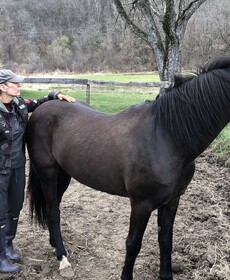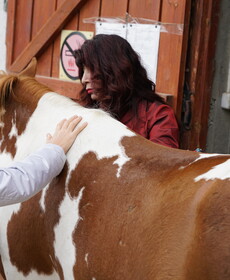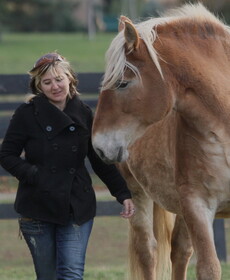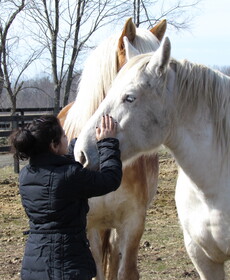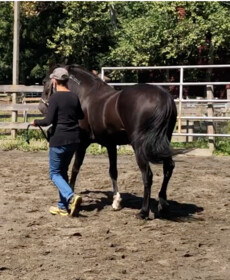EMBODIED HORSEMANSHIP
Equine-Supported Somatic Experiencing® Trauma Resolution
Other animals think with the whole of their bodies.David Abram
Connecting in an embodied way with horses opens us to discovering our authentic selves and learning new ways of settling and grounding body and mind. Horses, because they are highly sensitive, non-judgemental, non-predatory beings, can often help us with unresolved traumas that continue to impact us in an ongoing way. By releasing these habitual states of flight, fight and freeze, horses help us to become more comfortable in our own skin and more trustworthy to ourselves and others. With their help, we can find a more reliable sense of physical and emotional balance, resilience and ease. Horses, as vigilant prey animals, read not only our movement behaviors but their underlying emotional tone. Often our movement behavior and emotional expression unconsciously reflect an unsettled or distracted state of mind. As we bring greater mindfulness to how we move and the effect of our movement and emotions on the horse, their responses can help us feel when we are dis-regulated, anxious or unaware or finding a more regulated and easeful state of being. CO-REGULATION & CONNECTION
When we meet others - including other species - our systems begin to synchronize. This is sometimes called bio-synchrony. We begin to mirror each other's rhythms, movement, respiration, heart rate and emotional tone. This is a bodily, emotional sensing of another being - an empathetic, echolocating, embodied experience of reciprocal resonance. This co-regulating, co-embodying experience of connection helps to nurture an intuitive, improvisational, feeling response to what is arising in the moment rather than being caught in habitual or automatic ways of responding. With horses, this means finding a shared settled state with the horse, where we are listening more than telling, and creating opportunities for responsiveness and resonance rather than tension and reactivity. DOMINANCE AND NON-DOMINANCE
Our unconscious behaviors and inner emotions can create patterns that are rooted in a hierarchical, dominance-based way of experiencing relationships. Non-dominance, on the other hand, is a way of connecting with others that is rooted in kinship rather than power over, in improvisation rather than restriction, in responsiveness rather than control. Our emotions are created and grounded in our physiology. When another being senses threat, or feels that their safety or autonomy is endangered, they engage their survival physiology, usually in one of these three ways: fight, flight or freeze. The resulting stress physiology (fear, anxiety, depression) affects all of our metabolic functioning - our muscle tone, and the ability of multiple body systems to find regulation. The result is often a confused, frightened horse (or human) - head up, body tense, hyper-vigilant. That heightened sympathetic reaction is a non-learning state for both horse and human. If threat conditions are chronic, then the default settings in our systems, or in the horse's system become reflexive and fixed. In other words, there is a well-developed danger map with little access to a sense of safety. Somatic Experiencing® trauma resolution can be helpful with the following:
including developmental trauma.
Being with horses is an opportunity for discovering an improvisational and exploratory inter-being relationship using the shared languages of movement and touch. As we become attuned to the responses and expression of the horses, we are better able to notice what our own bodies are feeling and what our emotional responses are. Moving with a horse, touching a horse can be the beginning of a deeper relationship with ourselves. PRIVATE SESSIONS, WORKSHOPS & CLINICS:
I am available to teach at your facility, and enjoy working with you to develop a program that best suits your needs and interests. I also see clients privately both in my movement studio in Kent, CT, or at the barn in upstate New York with my horse partners Blue and Izarra.

